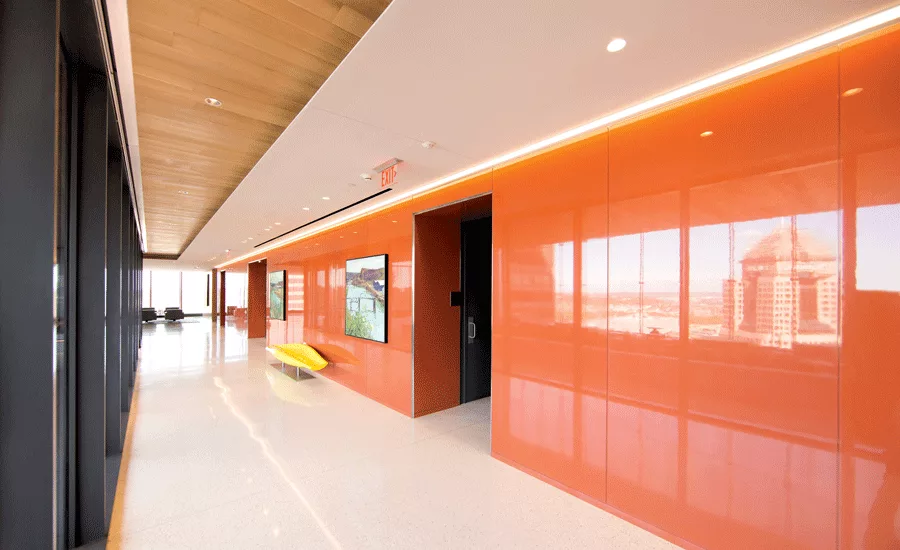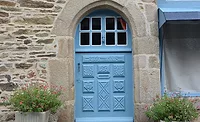PPG Products Featured in The Tower at PNC Plaza

Pittsburgh-based corporations PNC Financial Services Group and PPG have played integral roles in the development of sustainable architecture. PNC has more newly constructed LEED® (Leadership in Energy and Environmental Design)-certified green buildings than any company in the world, while its Steel City-based neighbor is the only building products company to offer customers such as PNC single-source access to sustainable glass, coatings and paints.
Given their proximity and history, it’s no surprise that PPG products have figured prominently in many of PNC’s signature architectural projects, including its boldest yet: The Tower at PNC Plaza. Opened in 2015 and planned to be one of the greenest office buildings ever built, the 33-story high-rise appears on the surface to be a conventional glass-and-steel skyscraper, yet the sleekly polished exterior hides a second glass façade that architectural firm Gensler designed, along with a rooftop solar chimney, to create a “breathing” building that uses fresh air and solar energy to naturally cool, heat and ventilate itself for much of the year.
Curtain Wall Glass and Coatings
Except for the metal framing, the double-skin façade for The Tower at PNC Plaza is constructed almost entirely with three PPG products. Sungate 400 passive low-e on STARPHIRE® glass, which was selected for its ability to trap solar heat in the winter and deflect it in the summer; Starphire Ultra-Clear glass, which was chosen for its exceptional transparency; and Coraflon Sunstorm powder coatings, which were specified for their sparkling mica appearance, hardness and near-zero VOC emissions. “Reducing energy use, maximizing natural light and optimizing occupant comfort were among the primary goals for The Tower at PNC Plaza, which earned LEED Platinum certification, the highest designation available from the U.S. Green Building Council,” says Patrick Finegan, Group Regional Manager, PNC Realty Services.
To accelerate achievement of these objectives, PNC and Gensler worked with the Permasteelisa Group to construct a 1,200-square-foot mock-up of the 800,000-square-foot structure using insulating glass units (IGUs) fabricated by J.E. Berkowitz. The exterior IGUs incorporated two lites of 5/16-inch Starphire Ultra-Clear glass with a laminated interlayer, while inner units were constructed of 1/4-inch Starphire Ultra-Clear glass and 1/4-inch Sungate 400 passive low-e on Starphire glass. Argon-gas-filled air spaces sealed with warm-edge spacers provided additional insulation, as did the thermally broken aluminum framing—finished with Coraflon Sunstorm Mica Gray powder coatings— which connected the IGUs to wooden mullions.
During testing and verification, the mock-up and sample IGUs exceeded design and performance expectations and the curtain wall design was subsequently specified for the entire building.
The Double-Skin Facade
The Tower at PNC Plaza ventilates using a window system in which the interior and exterior curtain walls are separated by an air cavity that provides insulation and helps control the building’s interior temperature.
During spring, summer and fall, warm fresh air enters the cavity through small, vertical windows on the exterior façade (which open and close automatically, depending on weather conditions) then passes through vents on the interior façade, rises and escapes through the solar chimney. In the winter, the operation is reversed. The solar chimney seals the air cavity, allowing fresh air to be trapped and warmed by the sun so that it can be circulated to help heat the building.
The thickness of the two-layer facade provides supplemental insulation throughout the year, and on warm, sunny days, automated blinds deflect heat to further reduce heat load and glare.
The Solar Chimney
The solar chimney consists of two vertical shafts located at the core of the tower, topped by a thick slab of concrete that is painted black and covered with glass. The black paint absorbs heat and warms the concrete, which creates a stack effect at the top of the chimney.
When the building automation system senses that conditions are optimized for natural ventilation, it opens the operable windows and vents on the interior and exterior facades so that air can enter the building, warm naturally, then rise and escape through the solar chimney. In natural ventilation mode, which is expected to occur up to 42% of the year, the building can operate without fan power or electricity.
The net effect of the ventilation scheme is to continually introduce fresh air into the building while reducing temperature-related energy consumption by up to 50% compared to similar-sized buildings.
PNC and Gensler specified a variety of sustainable glass, coatings and paint products by PPG to protect and beautify The Tower at PNC Plaza
Coraflon Sunstorm Powder Fluoropolymer Metal Coatings
Based on FEVE resin technology, Coraflon Sunstorm powder coatings deliver exceptional durability and weatherability in a wide range of colors and glosses, including the sparkling mica finish featured on The Tower at PNC Plaza. Like traditional liquid fluoropolymer coatings, Coraflon Sunstorm FEVE powder coatings and DURANAR® PVDF powder coatings feature equivalent performance that meets or exceeds American Architectural Manufacturers Association (AAMA) 2605 specifications for weathering, corrosion resistance, chemical resistance and other criteria on marquee building projects.
PPG PAINTS™
Inside The Tower at PNC Plaza, orange Manor Hall paint and Coraflon ADS powder mica gray coatings decorate the core walls at the elevator entrances, while Speedhide latex and Speedhide zero latex paints, and Pitt-Glaze waterborne acrylic epoxy colors such as Delicate White, Asparagus, Knight’s Armor, Black Magic and Glowing Firelight adorn offices, access areas, service centers, production rooms, restroom entrances and other spaces.
All PPG paints and metal coatings specified for The Tower at PNC Plaza were selected for their low-VOC emissions, durability and appearance.
The Greenest Office Tower in the World
In striving to create the greenest office tower in the world, PNC, Gensler and their partners constructed a building that was designed to surpass LEED Platinum certification.
In addition to a sophisticated double-skin façade that maximizes ventilation for heating and cooling and increases access to fresh air and natural light, The Tower at PNC Plaza operates highly-efficient water-based heating (radiant) panels and cooling (chilled beam) systems for supplemental heating and cooling.
Not only do these strategies enable The Tower at PNC Plaza to consume up to 50% less energy than benchmark buildings of its size, but the high-rise also bathes more than 90% of its workspace in natural light.
Photos are courtesy of Tom Cwenar.
Looking for a reprint of this article?
From high-res PDFs to custom plaques, order your copy today!







